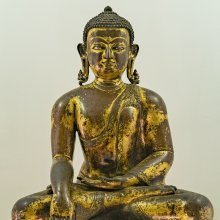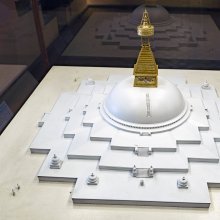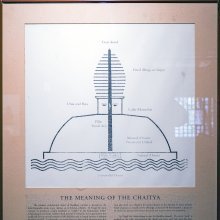Cudamani, Cūḍāmaṇī, Cūḍāmaṇi, Cuda-mani, Cuḍāmaṇi: 21 definitions
Introduction:
Cudamani means something in Buddhism, Pali, Hinduism, Sanskrit, Jainism, Prakrit, the history of ancient India, Marathi. If you want to know the exact meaning, history, etymology or English translation of this term then check out the descriptions on this page. Add your comment or reference to a book if you want to contribute to this summary article.
Alternative spellings of this word include Chudamani.
Images (photo gallery)
In Hinduism
Natyashastra (theatrics and dramaturgy)
Source: Wisdom Library: Nāṭya-śāstraCūḍāmaṇi (चूडामणि) refers to a “crest-jewel” and is classified as an ornament (ābharaṇa) for the head (śiras) to be worn by males, according to Nāṭyaśāstra chapter 23. It is to be worn on the top of the head. Such ornaments for males should be used in cases of gods and kings.
Cūḍāmaṇi (चूडामणि) also refers to a “crest-jewel” type of ornament (ābharaṇa) for the head (śiras) to be worn by females. Such ornaments for females should be used in cases of human females and celestial beings (gods and goddesses).
Ābharaṇa (‘ornaments’, eg., cūḍāmaṇi) is a category of alaṃkāra, or “decorations”, which in turn is a category of nepathya, or “costumes and make-up”, the perfection of which forms the main concern of the Āhāryābhinaya, or “extraneous representation”, a critical component for a successful dramatic play.

Natyashastra (नाट्यशास्त्र, nāṭyaśāstra) refers to both the ancient Indian tradition (shastra) of performing arts, (natya—theatrics, drama, dance, music), as well as the name of a Sanskrit work dealing with these subjects. It also teaches the rules for composing Dramatic plays (nataka), construction and performance of Theater, and Poetic works (kavya).
Ayurveda (science of life)
Rasashastra (Alchemy and Herbo-Mineral preparations)
Source: Wisdom Library: Rasa-śāstraCūḍāmaṇi (चूडामणि) is the name of an Ayurvedic recipe defined in the fourth volume of the Rasajalanidhi (chapter 2, dealing with jvara: fever). These remedies are classified as Iatrochemistry and form part of the ancient Indian science known as Rasaśāstra (medical alchemy). However, as an ayurveda treatment, it should be taken twith caution and in accordance with rules laid down in the texts.
Accordingly, when using such recipes (e.g., cūḍāmaṇi-rasa): “the minerals (uparasa), poisons (viṣa), and other drugs (except herbs), referred to as ingredients of medicines, are to be duly purified and incinerated, as the case may be, in accordance with the processes laid out in the texts.” (see introduction to Iatro chemical medicines)
Nighantu (Synonyms and Characteristics of Drugs and technical terms)
Source: WorldCat: Rāj nighaṇṭuCūḍāmaṇī (चूडामणी) is another name for Raktaguñjā, one of the two varieties of Guñjā: a medicinal plants identified with Abrus precatorius (Indian licorice or rosary pea) from the Fabaceae or “legume family” of flowering plants, according to verse 3.113-116 of the 13th-century Raj Nighantu or Rājanighaṇṭu. The third chapter (guḍūcyādi-varga) of this book contains climbers and creepers (vīrudh). Together with the names Cūḍāmaṇī and Raktaguñjā, there are a total of sixteen Sanskrit synonyms identified for this plant.

Āyurveda (आयुर्वेद, ayurveda) is a branch of Indian science dealing with medicine, herbalism, taxology, anatomy, surgery, alchemy and related topics. Traditional practice of Āyurveda in ancient India dates back to at least the first millenium BC. Literature is commonly written in Sanskrit using various poetic metres.
Chandas (prosody, study of Sanskrit metres)
Source: Journal of the University of Bombay Volume V: Apabhramsa metres (2)Cuḍāmaṇi (चुडामणि) is the name of metre similair to Āyāmaka which, both classified as Dvipadi (metres with two lines in a stanza) discussed in books such as the Chandonuśāsana, Kavidarpaṇa, Vṛttajātisamuccaya and Svayambhūchandas.—Āyāmaka has 33 mātrās in each of their two lines, made up by 7 caturmātras and 1 pañcamātra at the end. The yati in this is not mentioned and this means that it is the usual one coming after the 8th mātrā, the initial beat of the tāla being on the 1st mātrā.—When on the other hand, the initial beat is shifted from the first to the 3rd, 5th and 7th mātrās, and consequently the initial yati is shifted from the 8th to the 10th, 12th and the 14th mātrās, the same Āyāmaka is called respectively, Kāñcīdāma, Raśanādāma and Cuḍāmaṇi. The preposition ‘upa’ is prefixed to the names of these four metres, if their lines are formed with 1 ṣaṇmātra, 6 caturmātras, and 1 trimātra, instead of the usual 7 caturmātras and 1 pañcamātra.

Chandas (छन्दस्) refers to Sanskrit prosody and represents one of the six Vedangas (auxiliary disciplines belonging to the study of the Vedas). The science of prosody (chandas-shastra) focusses on the study of the poetic meters such as the commonly known twenty-six metres mentioned by Pingalas.
In Buddhism
Tibetan Buddhism (Vajrayana or tantric Buddhism)
Source: Wisdom Library: Tibetan BuddhismCūḍāmaṇi (चूडामणि) is the name of a Tathāgata (Buddha) mentioned as attending the teachings in the 6th century Mañjuśrīmūlakalpa: one of the largest Kriyā Tantras devoted to Mañjuśrī (the Bodhisattva of wisdom) representing an encyclopedia of knowledge primarily concerned with ritualistic elements in Buddhism. The teachings in this text originate from Mañjuśrī and were taught to and by Buddha Śākyamuni in the presence of a large audience (including Cūḍāmaṇi).

Tibetan Buddhism includes schools such as Nyingma, Kadampa, Kagyu and Gelug. Their primary canon of literature is divided in two broad categories: The Kangyur, which consists of Buddha’s words, and the Tengyur, which includes commentaries from various sources. Esotericism and tantra techniques (vajrayāna) are collected indepently.
In Jainism
General definition (in Jainism)
Source: archive.org: Een Kritische Studie Van Svayambhūdeva’s PaümacariuCūḍāmaṇi (चूडामणि) participated in the war between Rāma and Rāvaṇa, on the side of the latter, as mentioned in Svayambhūdeva’s Paumacariu (Padmacarita, Paumacariya or Rāmāyaṇapurāṇa) chapter 57ff. Svayambhū or Svayambhūdeva (8th or 9th century) was a Jain householder who probably lived in Karnataka. His work recounts the popular Rāma story as known from the older work Rāmāyaṇa (written by Vālmīki). Various chapters [mentioning Cūḍāmaṇi] are dedicated to the humongous battle whose armies (known as akṣauhiṇīs) consisted of millions of soldiers, horses and elephants, etc.
Source: archive.org: TrisastisalakapurusacaritraCūḍāmaṇi (चूडामणि) refers to the wife of king Ibhavāhana from Nāgapura, according to the Jain Ramayana and chapter 7.4 [Rāma and Lakṣmaṇa] of Hemacandra’s 11th century Triṣaṣṭiśalākāpuruṣacaritra: an ancient Sanskrit epic poem narrating the history and legends of sixty-three illustrious persons in Jainism.—Accordingly, “Now in the city Nāgapura lived King Ibhavāhana and his wife? Cūḍāmaṇi, and daughter, Manoramā. When she had reached rising youth, Vajrabāhu married her with a great festival, like the moon marrying Rohiṇī. He took Manoramā and started for his city with his wife’s brother, Udayasundara, accompanying him from devotion. [...]”.

Jainism is an Indian religion of Dharma whose doctrine revolves around harmlessness (ahimsa) towards every living being. The two major branches (Digambara and Svetambara) of Jainism stimulate self-control (or, shramana, ‘self-reliance’) and spiritual development through a path of peace for the soul to progess to the ultimate goal.
India history and geography
Source: archive.org: Personal and geographical names in the Gupta inscriptionsCūḍāmaṇi (चूडामणि) is a place-name classified as a nauyoga mentioned in the Gupta inscriptions. The Gupta empire (r. 3rd-century CE), founded by Śrī Gupta, covered much of ancient India and embraced the Dharmic religions such as Hinduism, Buddhism and Jainism. Cūḍāmaṇi literally means “a jewel worn by men and women on the top of the head” it denotes “the best or most excellent”. Combined with its epithet nauyoga, Cūḍāmaṇi signifies “the best of harbours”.
Source: Cologne Digital Sanskrit Dictionaries: Indian Epigraphical GlossaryCūḍāmaṇi.—(IA 26), an eclipse on certain days. Note: cūḍāmaṇi is defined in the “Indian epigraphical glossary” as it can be found on ancient inscriptions commonly written in Sanskrit, Prakrit or Dravidian languages.

The history of India traces the identification of countries, villages, towns and other regions of India, as well as mythology, zoology, royal dynasties, rulers, tribes, local festivities and traditions and regional languages. Ancient India enjoyed religious freedom and encourages the path of Dharma, a concept common to Buddhism, Hinduism, and Jainism.
Languages of India and abroad
Marathi-English dictionary
Source: DDSA: The Molesworth Marathi and English Dictionarycūḍāmaṇī (चूडामणी).—m (S) A jewel worn in a crest. Hence fig. A person or thing preeminently excellent.
Source: DDSA: The Aryabhusan school dictionary, Marathi-Englishcūḍāmaṇī (चूडामणी).—m A jewel worn in a crest.
Marathi is an Indo-European language having over 70 million native speakers people in (predominantly) Maharashtra India. Marathi, like many other Indo-Aryan languages, evolved from early forms of Prakrit, which itself is a subset of Sanskrit, one of the most ancient languages of the world.
Sanskrit dictionary
Source: DDSA: The practical Sanskrit-English dictionaryCūḍāmaṇi (चूडामणि).—
1) a jewel worn on the top of the head, a crest-jewel (fig. also).
2) best, excellent (usually at the end of comp.).
Derivable forms: cūḍāmaṇiḥ (चूडामणिः).
Cūḍāmaṇi is a Sanskrit compound consisting of the terms cūḍā and maṇi (मणि). See also (synonyms): cūḍāratna.
Source: Cologne Digital Sanskrit Dictionaries: Shabda-Sagara Sanskrit-English DictionaryCūḍāmaṇi (चूडामणि).—m.
(-ṇiḥ) 1. A jewel worn in a crest or a diadem. 2. The Gunja, (Abrus precatorius.) E. cūḍā a crest, and maṇi a jewel.
Source: Cologne Digital Sanskrit Dictionaries: Benfey Sanskrit-English DictionaryCūḍāmaṇi (चूडामणि).—m. a jewel worn in a crest or diadem, [Hitopadeśa] i. [distich] 211, M. M. (
Cūḍāmaṇi is a Sanskrit compound consisting of the terms cūḍā and maṇi (मणि).
Source: Cologne Digital Sanskrit Dictionaries: Cappeller Sanskrit-English DictionaryCūḍāmaṇi (चूडामणि).—[masculine] diadem (crest-jewel); the gem or best of (—°); [abstract] tā [feminine]
Source: Cologne Digital Sanskrit Dictionaries: Aufrecht Catalogus Catalogorum1) Cūḍāmaṇi (चूडामणि) as mentioned in Aufrecht’s Catalogus Catalogorum:—[dharma] Quoted by Raghunandana and Kamalākara. See Ācāryacūḍāmaṇi.
2) Cūḍāmaṇi (चूडामणि):—[anonymous] by Śaktibhadra. Oppert. 2605.
—[commentary] 2606.
3) Cūḍāmaṇi (चूडामणि):—author. See Kavicūḍāmaṇi, Rājacūḍāmaṇi.
4) Cūḍāmaṇi (चूडामणि):—on music. Quoted Oxf. 201^a.
5) Cūḍāmaṇi (चूडामणि):—on Hillāja, by Rāma. Devīpr. 79, 14.
6) Cūḍāmaṇi (चूडामणि):—son of Rāghavendra: Jñānāṅkura.
Source: Cologne Digital Sanskrit Dictionaries: Monier-Williams Sanskrit-English Dictionary1) Cūḍāmaṇi (चूडामणि):—[=cūḍā-maṇi] [from cūḍā > cūḍa] m. a jewel worn by men and women on the top of the head, [Mahābhārata i, 4628; vii, 826; Rāmāyaṇa] etc.
2) [v.s. ...] ifc. the (gem, id est. the) best or most excellent of [Kathāsaritsāgara cxxiii, 235; Dhūrtasamāgama i, 3; Vopadeva]
3) [v.s. ...] the seed of Abrus precatorius, [cf. Lexicographers, esp. such as amarasiṃha, halāyudha, hemacandra, etc.]
4) [v.s. ...] a metre of 4 x 7 syllables
5) [v.s. ...] an eclipse of the sun on a Sunday or an eclipse of the moon on a Monday, [Hemādri’s Caturvarga-cintāmaṇi i, 3; Gāruḍa-purāṇa]
6) [v.s. ...] a particular way of foretelling the future, [ccv]
7) [v.s. ...] Name of [work] on [astronomy]
8) [v.s. ...] of another on music
9) [v.s. ...] of a Kṣatriya, [Hitopadeśa iii, 9, 01]
Source: Cologne Digital Sanskrit Dictionaries: Yates Sanskrit-English DictionaryCūḍāmaṇi (चूडामणि):—[cūḍā-maṇi] (ṇiḥ) 2. m. A jewel worn in a crest; gunja.
[Sanskrit to German]
Sanskrit, also spelled संस्कृतम् (saṃskṛtam), is an ancient language of India commonly seen as the grandmother of the Indo-European language family (even English!). Closely allied with Prakrit and Pali, Sanskrit is more exhaustive in both grammar and terms and has the most extensive collection of literature in the world, greatly surpassing its sister-languages Greek and Latin.
Kannada-English dictionary
Source: Alar: Kannada-English corpusCūḍāmaṇi (ಚೂಡಾಮಣಿ):—
1) [noun] a small flat ornament, with a jewel, worn as a frontlet at the partition of hair in combing.
2) [noun] a person or thing that is par excellent in a particular class.
Kannada is a Dravidian language (as opposed to the Indo-European language family) mainly spoken in the southwestern region of India.
See also (Relevant definitions)
Starts with: Cudamani dikshita, Cudamanibhattacarya, Cudamanicakravartin, Cudamanicampu, Cudamanidhara, Cudamanidikshitiya, Cudamanijyotishashastra, Cudamanikerali, Cudamaninataka, Cudamanisara, Cudamanita.
Ends with (+42): Abhidhanacudamani, Acaryacudamani, Alamkaracudamani, Ankacudamani, Aparokshacudamani, Bhattacaryacudamani, Bhavacudamani, Cakracudamani, Candracudamani, Candrardhacudamani, Carucudamani, Caturacudamani, Chandashcudamani, Citracudamani, Divyacudamani, Ganitacudamani, Haracudamani, Hasyacudamani, Horacudamani, Kamacudamani.
Full-text (+85): Cudaratna, Haracudamani, Trinetracudamani, Cudamanidhara, Cudamanibhattacarya, Cudamanita, Candrardha, Kandarpacudamani, Bhavacudamani, Simantamani, Nakshatracudamani, Pancacudamani, Candracudamani, Cakracudamani, Nyayacudamaniprabha, Horacudamani, Yogacudamani, Cudamani dikshita, Vratacudamani, Prashnacudamani.
Relevant text
Search found 33 books and stories containing Cudamani, Cūḍāmaṇī, Cūḍāmaṇi, Cuda-mani, Cuḍāmaṇi, Cūḍā-maṇi, Cūḍā-maṇī; (plurals include: Cudamanis, Cūḍāmaṇīs, Cūḍāmaṇis, manis, Cuḍāmaṇis, maṇis, maṇīs). You can also click to the full overview containing English textual excerpts. Below are direct links for the most relevant articles:
Garga Samhita (English) (by Danavir Goswami)
Verse 1.8.12 < [Chapter 8 - Description of Śrī Rādhikā’s Birth]
Verse 1.2.40 < [Chapter 2 - Description of the Abode of Śrī Goloka]
Verse 1.16.6 < [Chapter 16 - Description of Śrī Rādhikā’s Wedding]
The Markandeya Purana (Study) (by Chandamita Bhattacharya)
Types of Ornaments < [Chapter 2]
Cosmetics, Costumes and Ornaments in Ancient India (by Remadevi. O.)
2.1. Head Ornaments (d): Cūḍāmaṇi < [Chapter 3 - Ornaments]
Chaitanya Bhagavata (by Bhumipati Dāsa)
Verse 2.12.18 < [Chapter 12 - The Glories of Nityānanda]
Verse 1.5.169 < [Chapter 5 - Eating the Mendicant Brāhmaṇa’s Offerings]
Verse 2.25.43 < [Chapter 25 - The Discourse on Spiritual Knowledge by Śrīvāsa’s Dead Son]
Amaravati Art in the Context of Andhra Archaeology (by Sreyashi Ray chowdhuri)
Making of a Monk and practice of Austerities < [Chapter 3 - Amarāvatī and the Formative Stage of the Buddhist Art]
Related products




